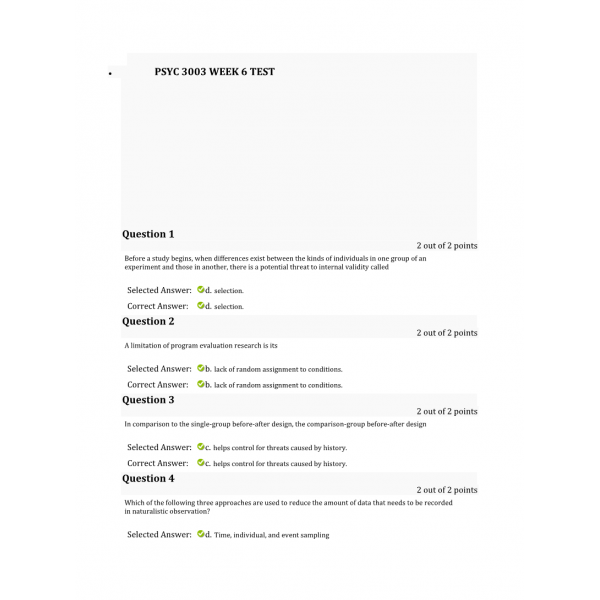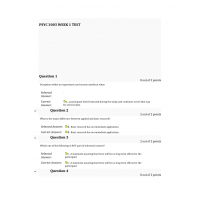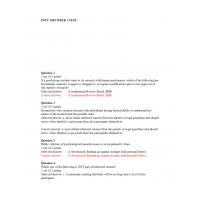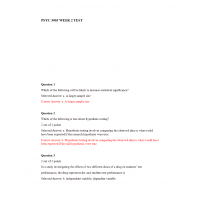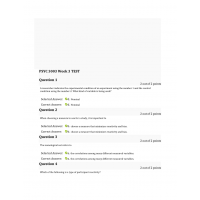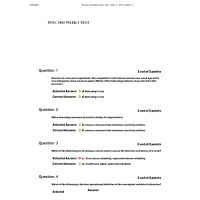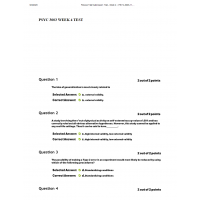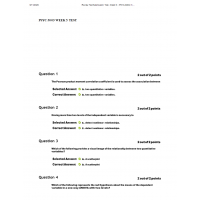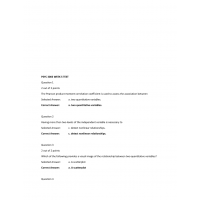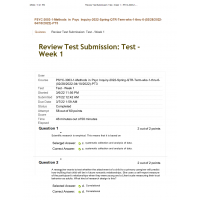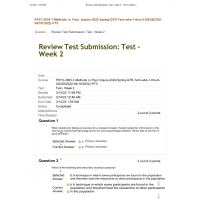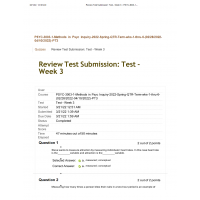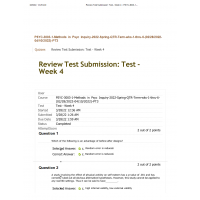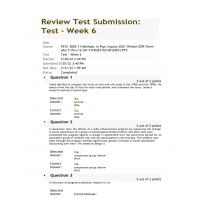PSYC 3003 Week 6 Test
1. Before a study begins, when differences exist between the kinds of individuals in one group of an experiment and those in another, there is a potential threat to internal validity called
2. A limitation of program evaluation research is its
3. In comparison to the single-group before-after design, the comparison-group before-after design
4. Which of the following three approaches are used to reduce the amount of data that needs to be recorded in naturalistic observation?
5. In a study involving altruism in restaurants, Elena focused only on the helping behaviors that each restaurant employee demonstrated (and not on any other types of behaviors). This is an example of which of the following sampling methods?
6. Which of the following is an example of a single-group research design?
7. Helen and her team of observers were hired by a corporation to examine work productivity. Each observer focused on a single worker for a period of 30 minutes before moving on to observe another worker. This is an example of which of the following sampling methods?
8. Buchanan, Tranel, and Kirschbaum (2009) compared three groups of participants, one of which had damage to the hippocampus, one that had similar brain damage but not to the hippocampus, and a control group of participants. The researchers assessed responses of the three groups both before and after they were exposed to stress. The hippocampus group showed less change in cortisol response to stress than the other two groups. What research design was used in this research?
9. Which of the following is least likely to be a threat to validity in a single-group before-after design?
10. Case studies are frequently based on a descriptive record of
11. Quasi experimental designs are usually analyzed using
12. Which of the following observational research methods is most likely to create ethical problems?
13. A student gets a 99 out of 100 on her first quiz in a psychology class but gets only a 91 on the next quiz. This is a likely example of which of the following?
14. Which of the following is NOT a quasi-experimental research design?
15. A study of parenting styles across generations samples groups of participants at ages 5, 15, and 20 at the same time. Which of the following terms best describes this design?
16. An advantage of a single-participant design is that
17. In order to reduce observer bias in an observational research design, a researcher might
18. A researcher who plans ahead of time exactly what observations he is going to be looking for is using
19. Quasi-experimental research designs are so named because
20. A researcher who simply watches behavior at a public children’ playground to learn about toddler play behavior is using which of the following techniques?
21. An experimenter is interested in the influence of taking a one-semester-long test preparation course on performance on the Scholastic Aptitude Test (SAT). She contacts high school students who have and who have not taken the course and compares their scores on the SAT exam. She finds that the students who have taken the course score significantly higher on the test. The research design is
22. A researcher is unable to retest some of his participants in a before-after design because they have dropped out of the program. This is an example of a(n) ________threat.
23. When it comes to control over the conditions in the experiment or over assignment of participants to groups in the experiment, a researcher in a natural setting is likely to have
24. In quasi-experimental research that is conducted over a period of time, the participants naturally get older. If the researcher is not interested in the effects of age on the dependent variable, then the changes in age pose which of the following threats to the validity of the research?
25. A scientist wants to study the behaviors of factory workers under stressful working conditions. She takes a job in a factory where no one knows her true identity. Which research approach is being used?
26. Nancy and her team of observers wish to collect data on “aggressive play” that occurs on an elementary school playground during recess. Rather than trying to record all of the children’s behaviors on the playground, each member on Nancy’s team is randomly assigned one child on the playground to observe for the entire duration of the recess. This is an example of which of the following sampling methods?
27. Regression to the mean causes interpretive difficulties when
28. It is most accurate to say that
29. Which of the following are most likely to be used in naturalistic research?
30. Jamal decides to compare the lyrics of rock and roll songs in the 1950s and the 1990s. He selects from the top 10 lists for each time period, and compares the lyrics. Jamal’s research method is based upon
31. A design in which behavior is initially measured during a baseline period, measured again after the intervention of interest begins, and then measured once more after the intervention is removed is called a
32. Which of the following statements is true about quasi-experimental designs?
33. In quasi-experimental research, longitudinal designs are to cross-sectional designs as
34. Joe decides to study how insects behave in their everyday life. He watches some ladybugs in his back yard and codes whether they are either living alone, living in groups, or living in pairs. Joe’s observational system is based on the use of which of the following?
35. A design in which behavior is initially measured during a baseline period and then measured again after the intervention of interest begins is called a
36. Which of the following could not represent a participant variable?
37. Students were given a pretest when their math class began and a posttest at the end of the semester. The students’ math performance increased. The teacher learned near the end of the semester, however, that in their science classes the students were using new computer software that included much of the math the teacher was covering in his course. Which of the following threats to internal validity does the new computer software represent?
38. In clinical trials involving tests of new medical treatments it may be extremely difficult to get patients to agree to be randomly assigned to either the treatment or the control group. In these situations researchers can use
39. Coding large amounts of information into systematic categories is known as
40. What type of research method assesses changes in behavior in one group of subjects at more than one point in time?
41. Fowler, Lilienfield, and Patrick (2009) studied the extent to which observers agreed on judgments of psychopathy after viewing “thin slices” (short glimpses) of the behavior of prisoners. The researchers based their findings on which of the following?
42. Buchanan, Tranel, and Kirschbaum (2009) compared three groups of participants, one of which had damage to the hippocampus, one that had similar brain damage but not to the hippocampus, and a control group of participants. The researchers assessed responses of the three groups both before and after they were exposed to stress. The hippocampus group showed less change in cortisol response to stress than the other two groups. What research design was used in this research?
43. When individuals’ performance on a posttest differs from their initial testing not because of a treatment but because of familiarity with the measure a __________ threat to internal validity is likely.
44. Which of the following represents the greatest limitation to drawing conclusions from a single group quasi-experimental design?
45. Research designed to study intervention programs with the goal of determining whether the programs are effective in helping the people who make use of them is called
| Institution & Term/Date | |
| Term/Date | Walden University |
PSYC 3003 Week 6 Test
- Product Code: 2022
- Availability: In Stock
-
$14.99
Related Products
PSYC 3003 Week 2 Test
$9.99
PSYC 3003 Week 4 Test
$9.99

